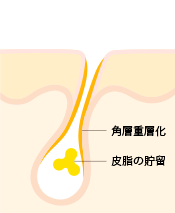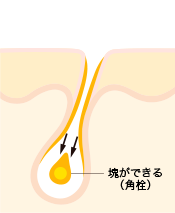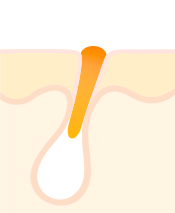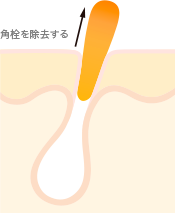「つまらない」研究のはじまり
角栓はとても小さなものですが、顔の中心にある鼻にできやすく肌の美しさの印象を妨げることから、多くの人が悩んできました。しかしこれまでは、角栓を取り除く方法の研究はあっても、角栓自体をできにくくする研究は、十分になされていませんでした。
角栓はとても小さなものですが、顔の中心にある鼻にできやすく肌の美しさの印象を妨げることから、多くの人が悩んできました。しかしこれまでは、角栓を取り除く方法の研究はあっても、角栓自体をできにくくする研究は、十分になされていませんでした。
取っても、取っても、何度もできるなら、できないようにするにはどうしたらいいか。繰り返す角栓に立ち向かうべく、イプサ研究員の「つまらない博士」こと、飯田年以さんチームが立ち上がりました。
取っても、取っても、何度もできるなら、できないようにするにはどうしたらいいか。
繰り返す角栓に立ち向かうべく、イプサ研究員の「つまらない博士」こと、飯田年以さんチームが立ち上がりました。
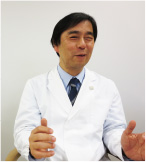

飯田年以 博士
博士の、「つまらない」を追求した研究
まず博士たちは、自分たちの鼻から角栓を採取。
マイクロメートルの小ささの角栓をはがしたり、切ったり、染めたり、溶かしたりと、
さまざまな実験をおこない、毛穴と角栓をじっくり観察しました。
まず博士たちは、自分たちの鼻から角栓を採取。マイクロメートルの小ささの角栓をはがしたり、切ったり、染めたり、溶かしたりと、さまざまな実験をおこない、毛穴と角栓をじっくり観察しました。
角栓形成のメカニズム
角栓とは、毛穴内部の角層のターンオーバーが乱れることで、不要な角層が通常より速く剥離してしまい毛穴からうまく排出されず、そこにベタベタした皮脂が付着することで、毛穴を塞ぐ栓になったもののこと。最初は小さな塊から始まりますが、このプロセスが繰り返されることで、次第に大きく成長していきます。たとえ取り除いても角層のターンオーバーは乱れたままなので、またすぐに角栓ができてしまいます。
角栓を取り除くだけでは、
角栓はまたすぐ再生する

イメージ
角栓は年輪
縦長の「栓」のように見える角栓ですが、横に割った断面図を光学顕微鏡で見てみると、過剰な皮脂と角層が幾重にも連なり、まるで年輪のようになっていることが分かります。また中には複数の毛穴から出た角栓が一体化しているものさえ見られました。
皮脂と角層は固く密着しあっており、またそれぞれ崩せる成分が異なるので、簡単には毛穴から溶かし出せません。博士たちはさまざまな成分を試し、皮脂と角層をまとめて効率よく溶かし出せる組み合わせを探し続けました。
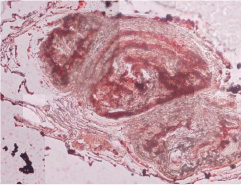

皮脂と角層は固く密着しあっており、またそれぞれ崩せる成分が異なるので、簡単には毛穴から溶かし出せません。博士たちはさまざまな成分を試し、皮脂と角層をまとめて効率よく溶かし出せる組み合わせを探し続けました。
毛穴の黒ずみの原因も判明!
実験の中で、黒い角栓と白い角栓を崩してみたところ、博士たちは角栓の中に皮脂や角層だけでなく、たくさんのうぶ毛が詰まっていることを発見しました。これまで毛穴の黒ずみの原因には皮脂の酸化やお手入れ不足などが挙げられることが多かったのですが、そうではなく、うぶ毛が大きく関係していることが確認されたのです。
角栓の成長を抑えるために
試行錯誤した結果、博士たちは最適な成分を見つけることができました。次に、最大の難関である角栓の生成を抑制できる成分を探しはじめました。被験者の毛穴に成分を塗り、塗っていないときとの角栓の成長過程を比較しました。たくさんの実験の末、ついに、角栓の成長を抑え、肌をスベスベにする成分にたどりつくことができました。博士たちは、この研究で多くの人の悩みを解決できるよう、「取り除く」と「成長を抑える」がそろった、毛穴の目立たない肌へ導く最適な化粧品を生み出したのです。
角栓をつくらない?詳しくはこちら角栓の疑問を「溶く」
さて、ここからは、角栓について、博士にいくつかの質問に答えてもらいました。
- なぜ鼻は角栓ができやすいの?
- 鼻は、顔のほかのエリアに比べて皮脂腺の働きが活発で、角層のターンオーバーが乱れやすいからです。また、その形状から、洗顔や化粧水などのケアが行き届きにくいということも、ターンオーバーを乱す原因の一つです。
- 角栓とニキビは違うの?
- 違います。まず、できる場所ですが、角栓は鼻など皮脂が多く大きな毛穴にできやすく、ニキビは額やアゴなど皮脂は多いのに毛穴があまり大きくないところにできやすいです。それから、角栓は炎症で赤くならず、肌表面が完全にふさがらない状態で皮脂が出てくるのに対し、ニキビは赤くなったりふさがっていることが多いです。また、アクネ菌などが角栓をエサにすることで、ニキビになる可能性があります。
- 洗顔では角栓は取れないの?
- 洗顔では完全に除去できず、根元は残っていることが多いです。また、特に年輪状にこびりついてしまった頑固な角栓は、取り除くための成分を毛穴の奥にまで届ける技術が必要です。
- お手入れをしたつもりなのに目立つような気がする…お手入れをしたつもりなのに
目立つような気がする… - 特にお風呂に入ったあとに顕著なのですが、ターンオーバーが乱れ硬くなっていた毛穴付近の角層がふやけることで、角栓が目立ってしまうことはあります。根元から取れやすくなっているいい状態なので、お手入れをするチャンスです。
- 角栓を取ったら毛穴は小さくなる?
- 角栓が大きくなって毛穴を押し広げている場合、取り除くことによって見た目は小さくなります。しかし、もともとの開きが小さくなるわけではなりません。下の図のように、毛穴の上に重なった角層によって入口が大きく見えているだけなのです。
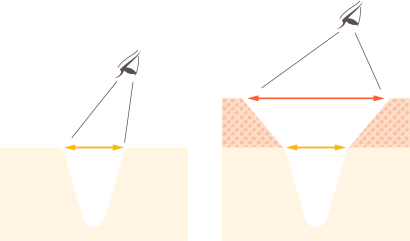

- 不要な角層
- 実際の毛穴の大きさ
- 広がってみえてしまう毛穴の大きさ
イメージ
つまらないから、おもしろい。
角栓のように小さいことをとことん追求、研究をしたつまらない博士と、どんなに小さな肌悩みにもお客さまのためのレシピを共創するイプサ。力を合わせて、「つまらない」角栓ケアを突き詰めていきました。






















